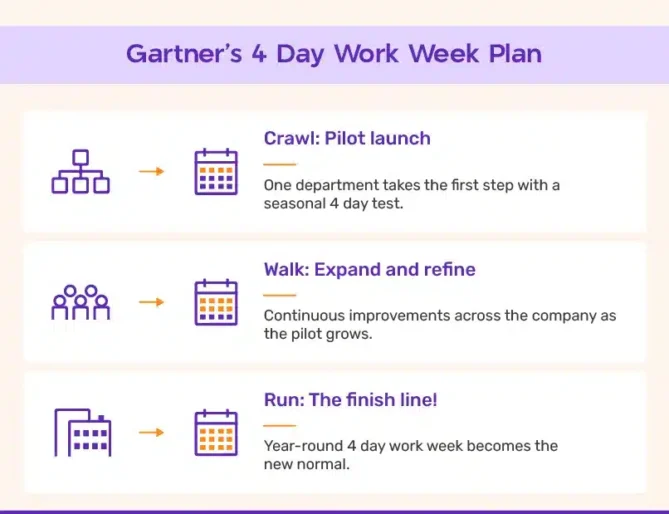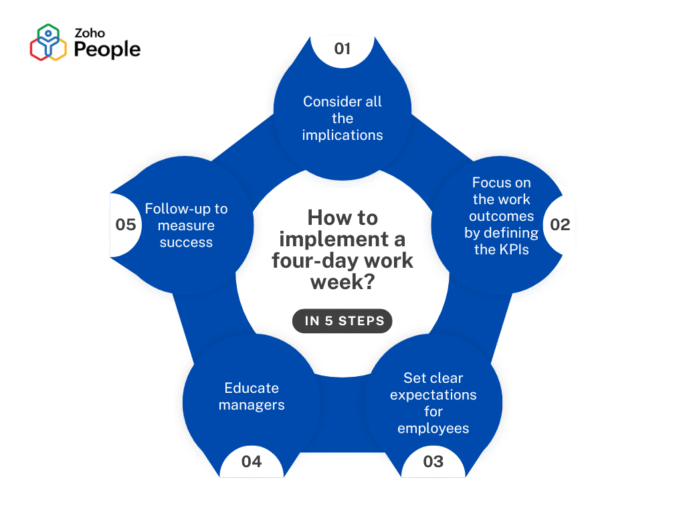The Global Shift Toward a Shorter Work Week
The conventional five-day workweek has been under the spotlight for companies and employees in the quest for a better balance between work and life, increased productivity, and good mental health; therefore, the four-day workweek has taken a strong grip globally as an idea where employees work fewer hours with no reduction in pay. The leading tests conducted in the UK, Japan, the US, and other countries registered an unbelievable hit to challenge old assumptions on productivity and workplace culture.
This article explores the real effects of adopting a four-day workweek by looking at examples from different fields, noting the advantages seen, and obstacles that arise for businesses in applying such a system. From small tech companies to factories, workplaces are finding that a reduced workweek can produce more content workers with less attrition
The UK’s Groundbreaking Four-Day Workweek Test
A top study on the four-day workweek was done in the UK in 2022 with 61 firms and more than 3,300 workers. The six-month test, set up by 4 Day Week Global along with scholars from Cambridge University, Oxford University, and Boston College, gave great results.

Firms said higher output, better worker wellness, and lower exhaustion. Money made by the companies went up by a typical of 1.4%, while missing work dropped a lot. Workers told us they got a better life at work, more time for home, and less worry as main perks. Importantly, 92% of firms decided to keep the four-day workweek after the test ended, showing it can work in the long run.
Success Stories from the UK Trial
- Pressure Drop Brewing (London): This craft beer company saw a 21% increase in revenue while maintaining production levels. Employees reported feeling more motivated and less fatigued.
- Royal Society of Biology: This nonprofit organization found that meetings became more efficient and staff were more engaged in their work.
- Yo Telecom: This telecom company reported a 20% reduction in staff turnover, attributing it to higher job satisfaction.
These findings suggest the four-day workweek is not just a perk for tech companies but can also benefit manufacturing, retail, and service-based industries.
Japan’s Experiment with Reduced Work Hours
Japan, known for its demanding work culture and high rates of karoshi (death from overwork), has also begun testing the four-day workweek. The Japanese government has actively encouraged companies to adopt flexible schedules to combat burnout and boost productivity.

Microsoft Japan’s Leading Test
In 2019, Microsoft Japan ran a test for one month wherein staff worked four days a week with full pay. The results were remarkable:
- Productivity rose by 40% due to shorter, more attentive working days.
- Electricity costs fell by 23% and employees printed 59% fewer pages, showing cost savings.
- Employee satisfaction climbed; 92% said their work-life balance had improved.
Despite these successes, widespread adoption in Japan remains slow due to deep-rooted cultural norms around overtime and presenteeism. However, some companies, like Panasonic and Hitachi, have started offering optional four-day workweeks to attract talent.
The US Movement: From Startups to Public Sector Adoption
In the United States, the four-day workweek has been catching on, most notably within the tech, healthcare, and education sectors. At present there is no nationwide mandate for it, just a patchwork of states and companies spearheading the effort.

Case Study: Bolt’s Permanent Shift to a 4-Day Week
This is a study of Bolt, a fintech company that made headlines in 2021 by shifting permanently to a four-day workweek. Its CEO, Markus Villig, reported:
- No fall in productivity—workers kept output up despite fewer hours.
- Getting new people became easier, with a jump in good candidates.
- Keeping employees has gotten better, with fewer workers quitting for other jobs.
Public Sector Adoption: Utah’s Experiment
In 2008, Utah initiated a four-day workweek for state employees with energy cost cuts and productivity as the supposed goals. This program initially saved $4.1 million in operational costs, with reported higher morale from the employees. However, it later developed into a challenge because of citizen complaints about reduced services on Fridays and eventually had to be discontinued. However, that has not stopped many local governments and school districts from exploring shorter workweeks.

Challenges and Criticisms of the 4-Day Workweek
Though the advantages are persuasive, the four-day workweek faces a lot of challenges. Some major obstacles include:
1. Sector-Specific Obstacles
A shorter week may not be possible for easy adoption by all sectors. In healthcare, emergency response, and retail, there is are continuous need for staffing, hence difficult to implement the four-day model without shift rotations or additional staff members.
2. Cultural Rejection
In nations with robust cultures of overtime (such as Japan and South Korea), superiors may be reluctant to cut down on hours as if it were a control associated with productivity.
3. Compensation and Job Concerns
Some employees are concerned that work-4-day weeks will mean 10-hour days plus more stress. Clear policies on how workloads are distributed would help make this successful.
The future of a 4-day workweek

As more companies and governments try out reduced hours, the 4-day workweek will likely become a normal option rather than a newfangled idea. Key trends to watch include:
1. Legislative Push in Europe
This is where you have it — Spain, Scotland, Iceland running government-backed trials, and more, to just implement this forever nationwide. For example, what happened in Iceland (where 2,500 workers participated) was that productivity either stayed the same or even increased at most workplaces.
2. Hybrid and Flexible Models
Others are trying a mixture of schedules, where workers switch between four and five-day weeks, or letting groups pick their way.
3. AI and Automation’s Role
Faster steps in AI and machines could make shorter workweeks more real by taking on repeat tasks, freeing workers up.



